NONNENHORN, GERMANY - We climb to the highest spot on Josef Gierer’s sloped vineyard where the young vintner uncorks one of his family’s best vintages and pours me a drink. The view from here is spectacular. Row after row of neatly-kept vines, lush with new growth, cascade down the rolling countryside before dropping off into lovely Lake Constance where the snow-capped Alps are reflected on the mirrored surface.
“From here you can see Switzerland and Liechtenstein,” says the proud Bavarian whose award-winning label — Winzerhof Gierer — is recognized as one of the area’s best.
For more than 300 years, Josef’s family has tilled this rich, fertile land that was made perfect for grape-growing during the last Ice Age.
“I come here when the sun is just beginning to set because the view inspires me. It makes me appreciate how fortunate I am to be living here and to be making wine,” says the likeable man with the red wine complexion.
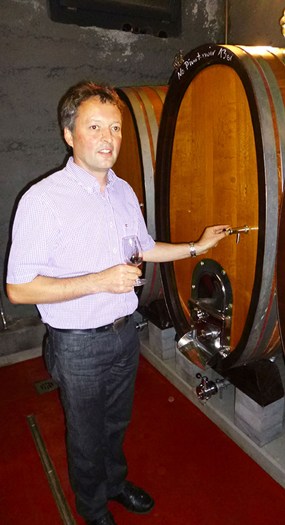
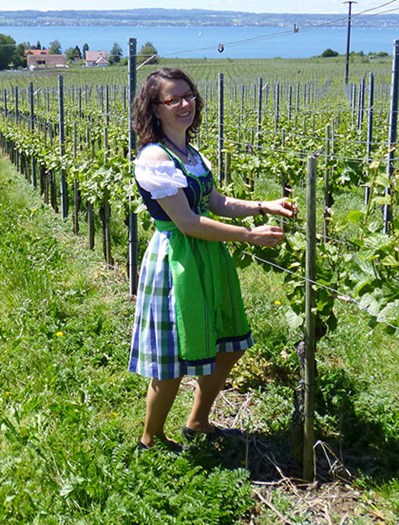
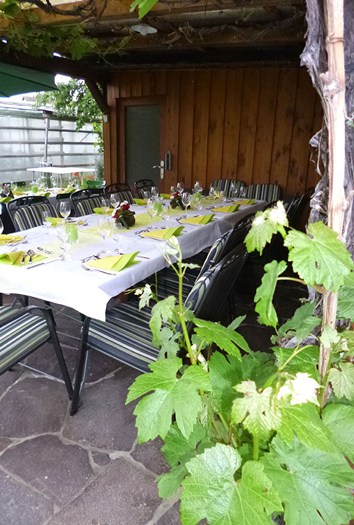
Left: Vintner Josef Gierer. Centre: Picking grapes in traditional dress. Right: Eating in the vines.
The vineyards in this quaint Bavarian hamlet (pop. 1,638) are all small, family-run operations like Josef’s, but unlike the rest of Germany where Riesling rules, the favourite wine here is Muller-Thurgau Trocken, a drier version of Riesling.
And now that’s he’s been made head of the family business, Josef has introduced some varieties of his own and proudly shows me a Sauvignon Blanc he recently produced. Even though it’s young, the crisp, tropical flavours are a welcome respite from the sweet Rieslings.
Persuading his father that his Sauvignon Blanc was a worthy addition to the winery’s shelves, however, wasn’t easy.
“At first my father did not like the taste of my Sauvignon Blanc, but a few glasses later he decided it would sell well,” laughs Josef, who lives on the compact vineyard with his entire family.
Visitors are always welcome here and stay in a small guesthouse the family has built at the front of the property. For just 80 euros ($120 Cdn) a night, you get to live the life of a winemaker and stay in one of five tastefully decorated apartments that all feature breathtaking views of the vineyard and surrounding brilliance.
“And your stay includes free wine tasting — all day!” emphasizes Josef with a devilish twinkle in his eye.
Josef is just one of the delightful people I meet on a drive through southern Germany’s Baden-Wurttemberg wine region that starts out in Stuttgart, where I meet a lovely “wine queen,” continues through a picturesque medieval wine town ruled by a good-natured prince, includes a visit to a magical Garden of Eden island in the middle of Lake Constance, and brings me to the front door of some interesting landmarks along the way.
And the mode of transportation I choose to make this drive fascinates people back home: a recreational vehicle (mobile camper), or caravan as it’s known here, which allows me to drive the winding back roads of wine country at my leisure and enjoy some of the remarkable camp sites where Germans like to spend weekends and holidays.
Not long after I arrive in Stuttgart, Germany’s Motor City where Porsche and Mercedes-Benz are headquartered, I meet Petra Hammer, a former regional wine queen who now works with a growers’ co-operative known as Collegium Wirtemberg to promote the wines of Uhlbach, the local district.

Above: Meersburg is one of the most charming cities in southern Germany.
On a clear night with the sun setting behind the majestic hills where the grapes grow, Hammer hosts an al fresco dinner of slow roasted lamb and pork accompanied by white asparagus in a vineyard overlooking Stuttgart.
She tells me that each German, on average, consumes 21 litres of wine a year, “but in Stuttgart, we drink 40 litres a year on average.”
In Stuttgart, they buy wine in six packs — daily!
Of the 13 wine-growing regions in Germany, Stuttgart, where the hearty pinot grape rules, is best known for the “freshness” of its vintages.
“Rieslings here are bolder and have more attitude than the Rieslings produced in other parts of Germany,” says Petra, as she pours a glass of Silvaner, an Old World wine that’s making a comeback.
Petra tells me “65 per cent of Germans drink red” and that “50 per cent of the wine produced in the Stuttgart region is consumed here.”
After sampling local varieties of Riesling (defiantly not as sweet as other German Rieslings I’ve tried); a Chardonnay that’s far less oaky than its French cousins, a Lemberger that’s made with a smaller berry that fortifies the taste, and a Trollinger that’s light in colour and taste, Petra introduces a “special” red called Trollinger 6 that “must be served at a temperature of 6 degrees Celsius to truly appreciate the taste.”
The cool red is a local favourite that’s usually consumed after a hard day’s work. The wine even has its own special glass that looks like a mini beer mug.
Next day, it’s time to start my wine road trip but first, I pick up the RV at the Hymer dealership just outside Stuttgart. Hymer (the Rolls-Royce of motor homes) is one of the oldest makers of caravans in Europe and the unit they have waiting for me looks like a 5-star hotel room on wheels.
However, before I get behind the wheel, I decide to tour the Erwin Hymer Museum across the street where the history of the “caravan” is documented in some very entertaining exhibits. During the tour, I learn that the first horse-drawn “caravan” appeared in England around 1885 and the name “caravan” comes from the Persian word meaning “travel with a group.”
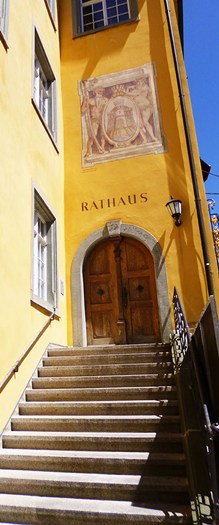
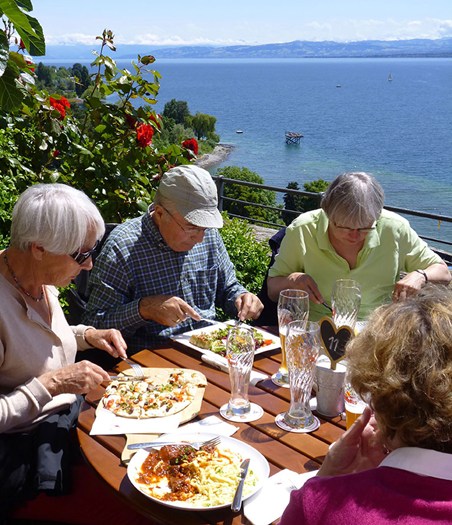
Left: Colourful Meersburg. Right: Tourists enjoying lunch overlook Meersburg's lake.
There are 80 vintage campers of various shapes and sizes on display in the museum and most date back to the turn of the 20th century. Erwin Hymer, to whom the museum is dedicated, was one of the earliest pioneers of the mobile camper.
It takes a bit of time getting used to driving the sleek camper along the tight, winding roads that lead to the Gitzenweiler Hof campground on the edge of Lake Constance, where I spend my first night camping under the stars since my time in the Boy Scouts. The plush campground, which features a supermarket-style grocery store, a pub and an adjacent restaurant, offers some of the cleanest bathroom and shower facilities I’ve ever seen. The cost of an overnight stay here equals about $30 Cdn. but the experience of meeting other campers is priceless.
Next day, I’m up bright and early, shower and hit the tourist route around Lake Constance, which leads me to the fairy-tale town of Meersburg. From a point overlooking the medieval town’s busy ferry port, I’m awed by the view of Lake Constance and the Alps in the distance.
Famous for its two castles — New Castle and Old Castle — Meersburg is a popular tourist haunt with Germans and their neighbours and the town square, surrounded by half-timbered houses and large candy-coloured public buildings, is one of the most delightful in Europe.
A short time later, the road leads me to the entrance of Schloss (Castle) Salem where I meet the delightful Bernhard, Prince of Baden, who presides over one of Germany’s most famous family vineyards.
The castle, which is home to a prestigious private school that Prince Philip, the Duke of Edinburgh, once attended, was presented to Bernhard’s family by Napoleon and the former monastery is a one of the most beautiful castles anywhere. Its grand halls and abbey, filled with priceless artifacts and decorated with elaborate gilded ceilings, are fascinating to tour and in the castle’s wine cellar visitors are treated to some rare vintages.
Prince Bernhard makes an appearance during my tour and delights with tales about his family’s past and excites with samplings of his vineyard’s Sekt (champagne), Muller-Thurgau, Chardonnay and a Riesling that costs about $60 Cdn a bottle. The taste of each is exquisite and it’s not hard to understand why the Weingut Markgraf von Baden label is so highly respected throughout Europe.
On Day 3 of my drive, I visit the Winery Schmid, the highest vineyard in Germany offering more spectacular views of Lake Constance and the Alps. The family is celebrating the completion of a new reception hall when I arrive and proudly shows off the Swiss-designed building with the modern edges.
When I pull into the Campground and Hotel Wirthsof a few hours later, I just have enough energy to enjoy a meal at the on-site restaurant before curling up in the RV’s comfy bunk and quickly fall to sleep.
On the final day of my drive, I head back to Meersburg to catch a ferry to lovely Mainau Island, a former royal retreat that is now one of Germany’s most treasured botanical sanctuaries.
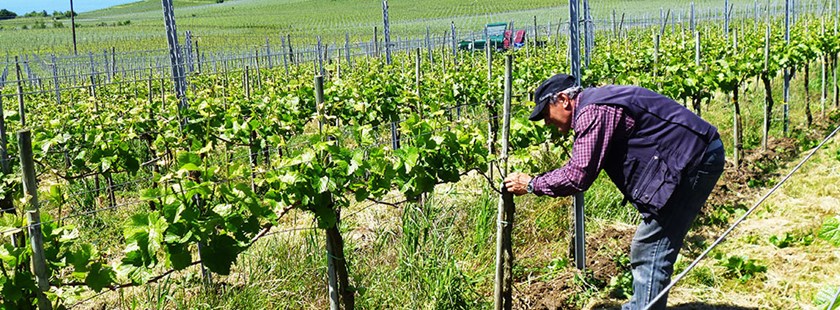
Above: Family vineyards are loving cared for by skilled growers.
On the way, however, I can’t resist a stop at the Dornier Aerospace Museum in Friedrichshafen, another lovely town on the edge of Lake Constance. The museum honours Claude Dornier, a pioneer of the German aerospace industry and the displays of pre- and post-World War II planes and missiles are truly worth the stop.
After parking the RV, I hop aboard the Mainau Island ferry and as it pulls out of port, I get a wonderful view of the lovely buildings that line the shore, including Meersburg’s Old Castle, which dates back to 630 AD.
The air on Mainau is perfumed with floral scents and the island once owned by Grand Duke Frederick I of Baden (he bought it and built a summer palace here) has become one of Germany’s most-visited attractions.
Giant redwoods imported from the United States that have grown to dizzying heights and gardens flush with a rainbow of colours are what keeps people spellbound during a visit here. The island also has its own vineyard and the summer palace and adjacent church are all must-sees.
My unique tour of Germany’s southern wine region ends in Konstanz, a lovely university town that borders Switzerland where the Rhine River flows into Lake Constance. I hand over the RV keys to the local Hymer dealer and board a plane back to Stuttgart for my onward flight home.
As the plane flies over the lovely vineyards, I sit back in my seat, remember all the great people I’ve met and the wonderful things I’ve seen on this journey while sipping a glass of Riesling.
It’s the perfect way to end this fabulous tour of Germany’s loveliest wine region.